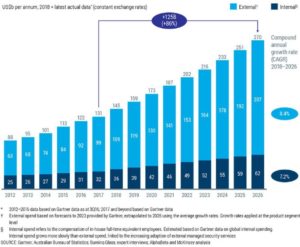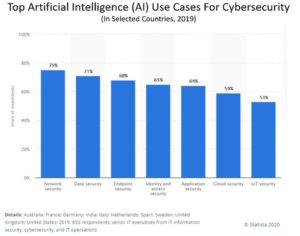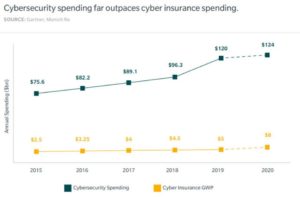Cybersecurity, the term that needs no introduction in this current day where computing network has a dominant role in running businesses.
The changing technology advancements provided the industry with never-before options that drive the business growth at a faster rate.
Alongside, new cybersecurity risks continued to challenge the advancements.
So, the current trend is undoubtedly an intense fight between advanced technologies and emerging cyber threats.
With this, IT security posture has become the need of the hour naturally, resulting in a massive demand for IT infrastructure security and related expenditure.
IT Security on Demand
The global IT security spending is likely to reach USD 128 billion by 2020.
Of this, endpoint security is likely to account for 24 percent of the overall spending, given the fact that 70 percent of all breaches happen at endpoints.
Spending focused on infrastructure protection is likely to grow from USD 18.3 billion in 2020 and further to USD 24.6 billion by 2024, at a 7.6 percent CAGR.
Meanwhile, increasing cloud adoption is driving firms to spend more on cloud security solutions and tools. The spending in these two areas is likely to be around USD 12.6 bn and 1.6 bn, respectively, by 2023.
Meanwhile, 71 percent of UK-based decision-makers feel that the remote work option during the COVID-19 crisis has contributed to the rise of cybersecurity risks.
ALSO READ: US Cyber Security: 164 Million Records Exposed in 2019
Around this scenario, here are some critical cybersecurity predictions for 2020 and beyond, drawn from various market research estimates:

1) Global Cybersecurity Market
The global cybersecurity market is likely to be worth USD 173 bn in 2020 and poised to be a USD 270 bn market by 2026, with 77 percent spending around managed security services.

Alongside, the internal security investment is likely to grow by 7.2 percent every year until 2026. Spending on external cybersecurity products and services is expected to grow 8.4 percent annually.
Meanwhile, spending on Identity Access Management and information security market has increased to USD 10.5 bn and USD 64.24 bn, respectively, in 2019.
The APAC cybersecurity market is likely to progress with a 20 percent CAGR by 2025.
2) Leading AI Use-cases in Cybersecurity
Network, data and endpoints are the top three AI use cases in cybersecurity, say IT executives from 10 different nations. Of this, endpoint security has become the top priority owing to the rise in the remote workforce due to the COVID-19 lockdown.

Fraud, malware, and intrusion detection are among popular AI use-cases.
ALSO READ: How to Implement ‘Cybersecurity’ in Your Project?
3) Mobile Threats on Rise
According to Verizon’s Mobile Security Index 2020, 87 percent expect a continuous rise in mobile threats compared to other threat forms this year. Organizations propose the zero-trust framework as a means to contain such attacks. Securing devices on the zero-trust platform built using the Unified Endpoint Management (UEM) can prevent such attacks, says the report.
4) Global Cyber Insurance Market
The global cyber insurance market is likely to become a USD 8 billion market in 2020. Cyber insurance is being looked at as a security tool and resource for cyber risk management.

5) Endpoint Failures
Around 42 percent of the endpoint failures report encryption failures. Majority of them fail due to weak encryption agents’ configuration, which either fails every week or once in two weeks. This was summarized based on the data reported from incidents of 1 billion change events in 6 million devices.
6) Data Breach Costs
The average cost of a data breach reported by US companies has increased from USD 3.54 million in 2006 to USD 8.19 million by 2019, a 130 percent rise in 14 years. Healthcare reported the highest costs at USD 6.4 million, 65 percent higher than the average total cost.
ALSO READ: Cybersecurity for SMBs: Importance, Challenges and Benefits
7) Rise in Frauds
According to a PwC study, 47 percent of companies experience some fraud in the last 24 months. The rate of fraud is much higher than that of cyber risks, asset misappropriation and others.
8) Remote Working Contributed to Breaches
Seventy-one percent of UK-based IT decision-makers feel that 100 percent of remote working has increased the likelihood of cyber breaches. While 53 percent believe IT admin remote access is at risk, 46 percent have already reported a rise in phishing attacks since the remote working began. Majority of the companies have already beefed up their cybersecurity posture, while some are already training their employees on cyber safety.
In Conclusion
It’s time to revisit your IT security posture and get the things done right well before the problem occurs. Gear up for next-level information security services with StealhLabs!

